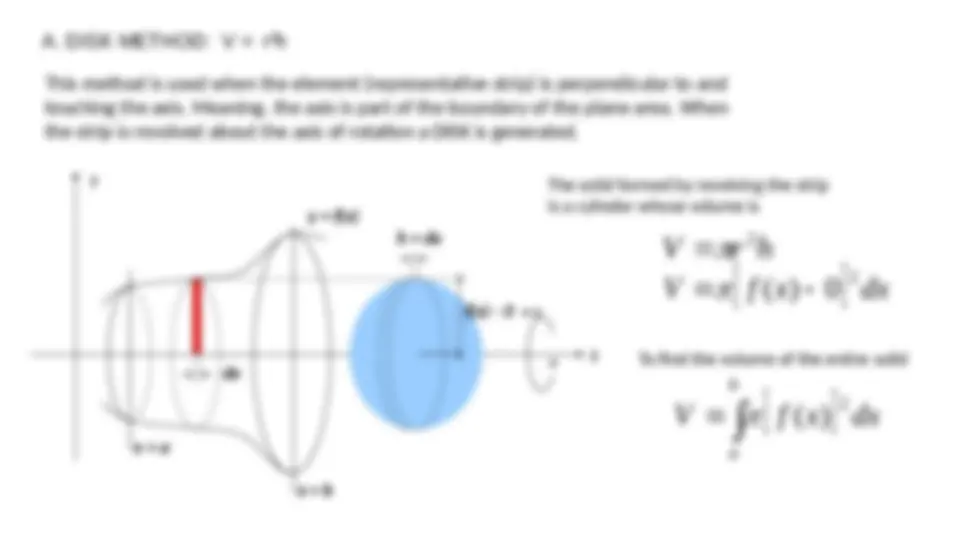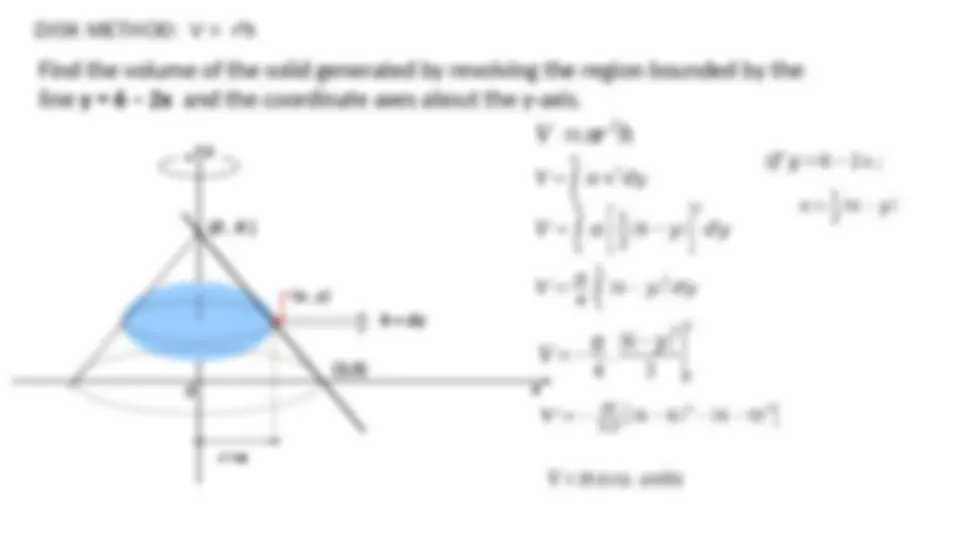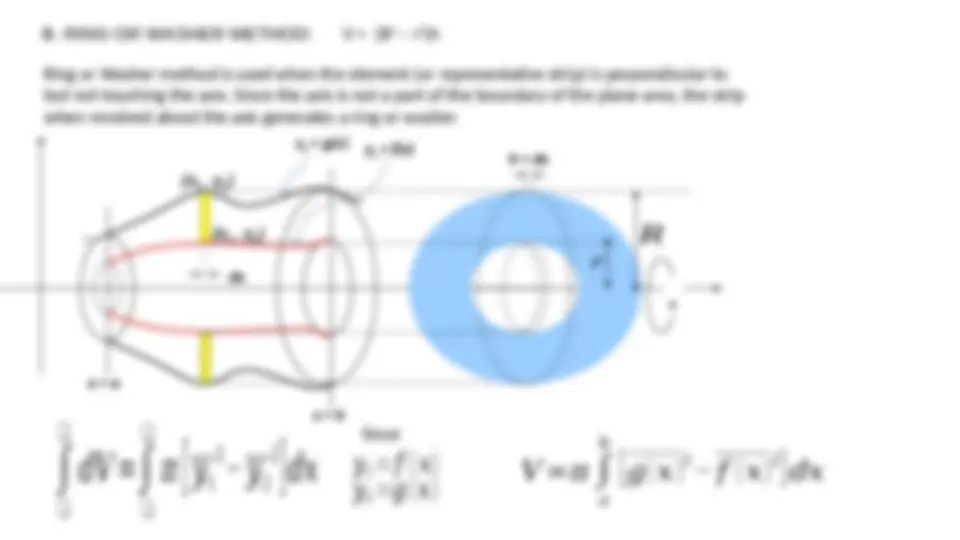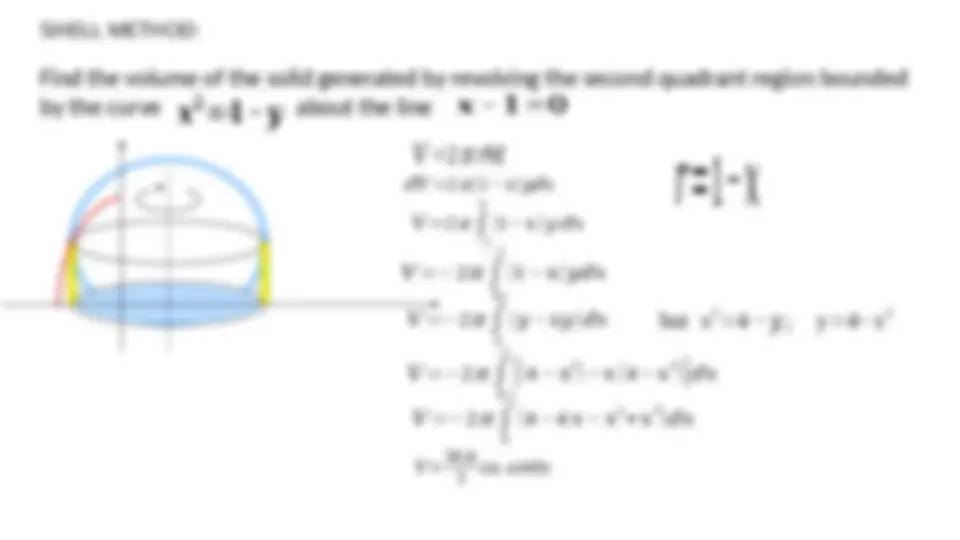






Study with the several resources on Docsity

Earn points by helping other students or get them with a premium plan


Prepare for your exams
Study with the several resources on Docsity

Earn points to download
Earn points by helping other students or get them with a premium plan
Community
Ask the community for help and clear up your study doubts
Discover the best universities in your country according to Docsity users
Free resources
Download our free guides on studying techniques, anxiety management strategies, and thesis advice from Docsity tutors
The concept of solid of revolution and the methods to calculate its volume. It describes the Ring or Washer method, which is used when the element is perpendicular to but not touching the axis. It also explains the Shell method, which is used when the element is parallel to the axis of revolution. an example of finding the volume of a solid generated by revolving the second quadrant region bounded by the curve about R =1-x using the Ring or Washer method.
Typology: Lecture notes
1 / 8

This page cannot be seen from the preview
Don't miss anything!





DISK METHOD: V = r
2
h
r =x
( x , y )
h = dy
( 0 , 6 )
x
y
0
(3,0)
𝑉 =
0
6
𝜋 𝑥
2
𝑑𝑦
𝑉 =
0
6
𝜋
[
1
2
]
2
𝑑𝑦
𝑉 =
𝜋
4
0
6
( 6 − 𝑦 )
2
𝑑𝑦
( 6 − 𝑦 )
3
|
0
3
𝑥=
1
2
( 6 − 𝑦
)
𝑖𝑓 𝑦 = 6 − 2 x ;
𝑉 = −
𝜋
12
( 6 − 6
)
3
−
( 6 − 0
)
3
V r h
2
Ring or Washer method is used when the element (or representative strip) is perpendicular to
but not touching the axis. Since the axis is not a part of the boundary of the plane area, the strip
when revolved about the axis generates a ring or washer.
B. RING OR WASHER METHOD: V = (R
2
2
)h
( x
1
, y
1
)
( x
2
, y
2
)
x = a
x = b
dx
h = dx
y
1
= g(x)
y
2
= f ( x )
❑
❑
𝑑𝑉 =
❑
❑
𝜋
[
𝑦
1
2
− 𝑦
2
2
]
𝑑𝑥
Since
𝑦
1
= 𝑓 (𝑥)
𝑦
2
=𝑔 (𝑥)
𝑉 =𝜋
𝑎
𝑏
[ 𝑔 ( 𝑥 )
2
− 𝑓 ( 𝑥 )
2
] 𝑑𝑥
R
The method is used when the
element (or representative strip) is
parallel to the axis of revolution.
When this strip is revolved about
the axis, the solid formed is of
hollow cylindrical form.
𝑉
= 2 𝜋 𝑟𝑡 ⋅ h
𝒙
𝟐
= 𝟒 − 𝒚
𝑑𝑉 = 2 𝜋 ( 1 − 𝑥 ) 𝑦𝑑𝑥
𝑉 = 2 𝜋 𝑟 𝑡 h
𝑉 = 2 𝜋
− 2
0
( 1 − 𝑥 ) 𝑦 𝑑𝑥
0
− 2
0
− 2
but x
2
= 4 − 𝑦 ; y =4− x
2
0
− 2
[
( 4 − 𝑥
2
) − 𝑥
( 4 − 𝑥
2
) ] 𝑑𝑥
0
− 2
( 4 − 4 𝑥 − 𝑥
2
3
) 𝑑𝑥
𝑉 =
56 𝜋
3
𝑐𝑢. 𝑢𝑛𝑖𝑡𝑠